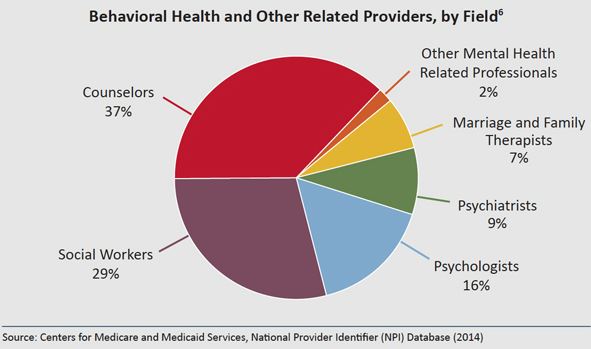Main Content
Lesson 1: Abnormal Behavior
Psychotherapy
Fact or Myth?
Psychotherapy is more effective than medication for most mental disorders.
The mental health world is very diverse and convoluted and can thus be a little confusing, and there are over 400 different kinds of psychotherapy (Prochaska & Norcross, 2007). Psychotherapy is performed by many different people with various educational and training backgrounds. The pie chart in figure 1.1 is from a study conducted in May of 2014, and as you can see Ph.D.-level psychologists only make up about 16% of all mental health professionals. Master’s-level clinical social workers and mental health counselors make up a large majority of those who conduct psychotherapy and other forms of mental health treatment (Centers for Medicare and Medicaid Services, 2014).

Explanations and treatments of abnormal behavior vary based on the mental health professional’s philosophical and theoretical lens, and those 400+ types of therapy become less confusing and less intimidating when you realize that most of them can be boiled down to the four main theories of psychotherapy: Psychodynamic, Behavioral, Cognitive, and Humanistic. Each of these four main theories enacts change through a different route or focus:
Psychodynamic
A key for psychodynamic therapy is “consciousness raising”, or raising awareness of one’s maladaptive patterns that may stem from problematic childhood experiences. For example, let’s say that a man was overprotected by his mother as a child so now he is very clingy and dependent in romantic relationships; a psychodynamic therapist would help the client to develop insight by becoming more aware of this relationship pattern and would then use that insight to improve his relationships.
Behavioral
The major key for behaviorists is, not surprisingly, to simply change a client’s behavior in a concrete way. For example, if a client is addicted to pornography then a behaviorist would focus on reducing the number of times per week that the client watches pornography.
Cognitive
Cognitive therapists tend to focus on the “inner dialogue” that we all have within our minds, and they typically try to change irrational or negative/self-defeating thoughts. For example, let’s say that a client with depression keeps having thoughts like “I’m a failure” or “I’m worthless”; a cognitive therapist would scientifically examine those thoughts with the client to point out how they’re not necessarily true while also coming up with more positive thoughts such as “I have value”.
Humanistic
Humanistic therapists use empathy, support, and a nonjudgmental stance toward clients to validate them and make them feel safe to be themselves. They also use techniques such as reflection of feeling to help a client engage in emotions that they need to get in touch with. For example, imagine that a psychotherapy client had a loved one die a few years ago but never really dealt with the emotions surrounding the loss; a humanistic therapist would have the client experience those emotions and would then validate them to ultimately help the client come to terms with the loss.
Many psychotherapists nowadays are eclectic, meaning that they utilize multiple theories instead of just one. Cognitive-Behavioral Therapy (CBT) is obviously a combination of the two, which brings us to our next Fact or Myth.
Brainstorm Ideas
Think about these questions as you generate thoughts and ideas in preparation for the Lesson 1 Discussion Forum questions found at the end of the lesson.
- What are some possible reasons why therapy is more effective than medication in most instances?
- What are some reasons why many people think or hold onto the belief that medication is more effictive?
- What are some explanations as to why medication by itself has a high relapse rate?
